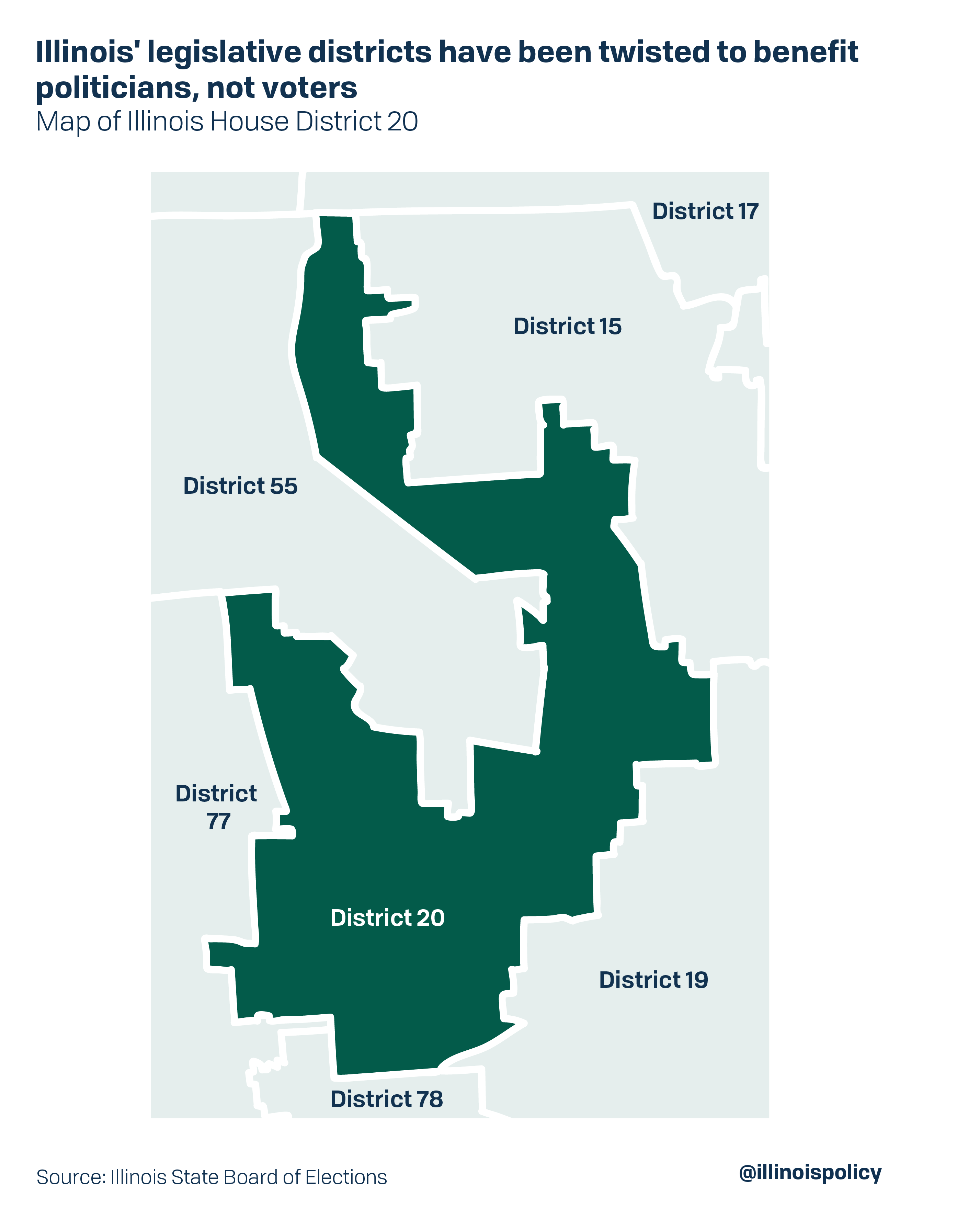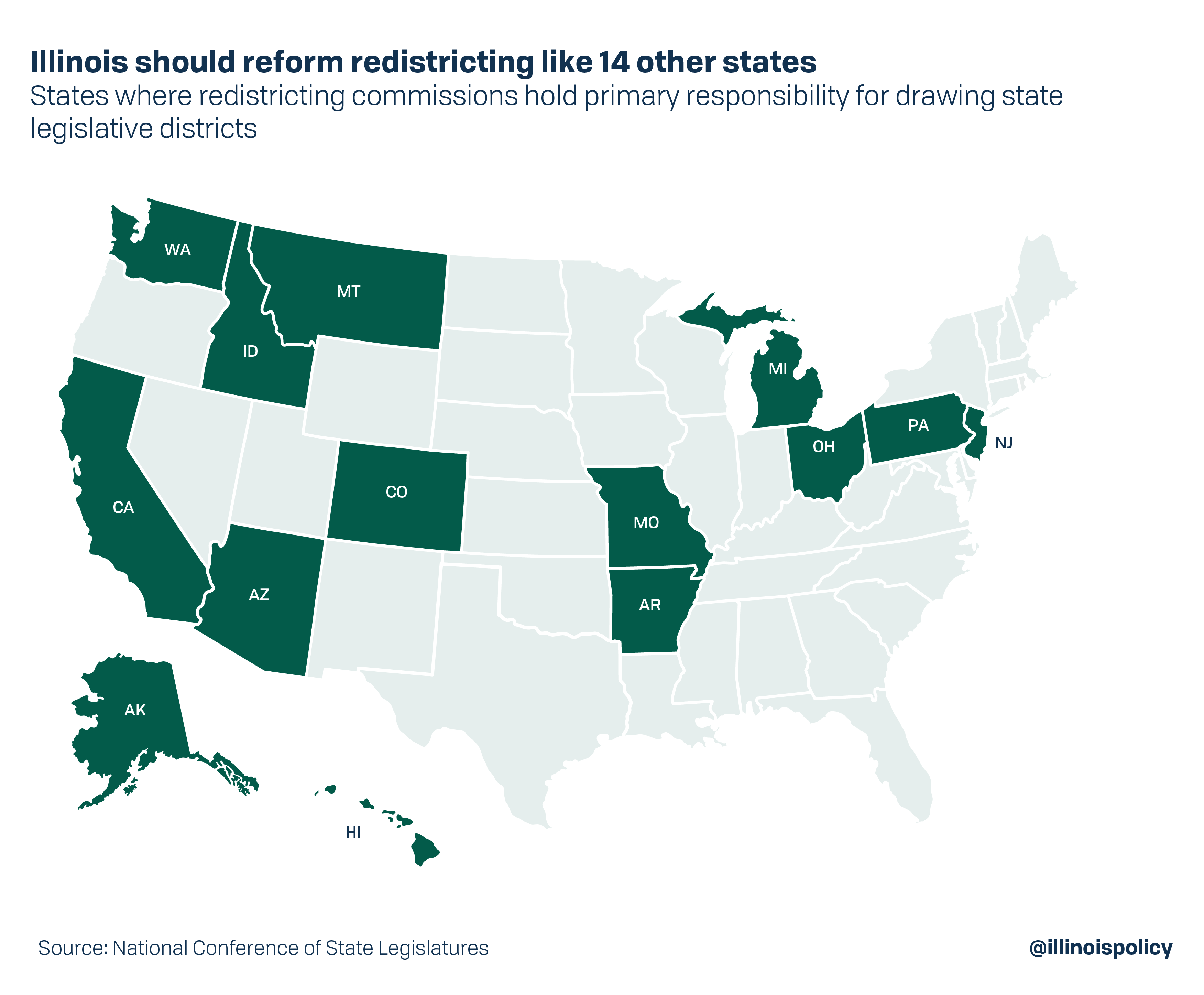To end gerrymandering, Pritzker should push redistricting reform
Illinois’ governor pledged to veto any map gerrymandered by state lawmakers, but it’s the process of mapmaking that needs to change.
Illinois needs to end partisan gerrymandering. Gov. J.B. Pritzker agrees, repeatedly backing redistricting reform in Illinois. He said as governor he would “support ending the gerrymandering of districts to encourage more competitive elections.” He even said he would veto any gerrymandered electoral map.
The next federal and state maps will be drawn on Pritzker’s watch in 2021, using information from the 2020 Census. Pritzker is right to question the current map-drawing process. Gerrymandering is a perennial problem that allows politicians to avoid accountability by making sure they don’t have to compete for votes. But for some states, including Illinois, the problem is pronounced.
Illinois needs to bring back political competition to the many legislative districts that lack it by overhauling its mapmaking process. The state should divorce the redistricting process from the politicians who stand to benefit from gerrymandering. How? By amending the Illinois Constitution to place redistricting in the hands of an independent redistricting commission and relying in part on mathematically generated maps.
The undemocratic results of Illinois’ mapmaking process
In the 2018 election, nearly half of the Illinois House of Representatives seats were uncontested. In the Illinois Senate, 20 of 39 senators up for election faced no opponent. There is little incentive to vote when there is no choice on the ballot. When map-drawing powers change hands, fortunes can dramatically swing.
In 2011, Democrats drew lines to force incumbent Republicans into the same district to either face primaries against each other or abandon re-election. Republicans don’t have much room to complain – they did the same thing in 1991 when they drew the maps. Two incumbent Democratic state senators, Ted Leverenz of Maywood and Richard Kelly Jr. of Oak Forest, were redistricted into heavily Republican areas after each had served for over a decade. Both ultimately lost their seats. While lawmakers on the wrong side of gerrymandering might be map casualties, it is Illinois’ voters who ultimately lose the map war.
Illinois’ mapmaking process
How did Illinois elections become so uncompetitive? How did so many seats become safe for incumbents? The state’s mapmaking process is largely to blame.
Who draws the map?
The Illinois Constitution establishes the redistricting process for state legislative seats in Illinois. For Congressional districts, the state redistricts through statute passed by the General Assembly and signed by the governor. Under these provisions, redistricting takes place every decade in the year following the U.S. Census. The next map for both state legislative and Congressional districts will be drawn in 2021, after the 2020 Census.
For state legislative districts, if the General Assembly cannot pass a redistricting bill, there is an eight-member backup redistricting commission.
If the proposed map is unable to gain approval of five commission members, the Illinois Secretary of State randomly draws a tie-breaker from a pool of two people from different parties. In practice that is either a Democrat or a Republican.
If the process goes this far, the result is a winner-take-all map. That is exactly what happened in three of the past four redistricting cycles. Both parties have drawn maps to their advantage.
Criteria used to guide mapmaking
There are some very basic requirements mapmakers must currently follow in Illinois:
- Allow racial or language minority communities to influence the election of their preferred candidates where possible, even if that district would not be required by the federal Voting Rights Act
- Be compact
- Be contiguous
- Be substantially equal in population
Otherwise, the mapmakers are free to draw maps to their maximum political advantage, resulting in the tortured twists and turns in Illinois districts today.

But that is not how it has to be. Other states have taken steps toward redistricting reform: Illinois can learn from them.
The path forward
Who draws the maps?
Pritzker explicitly cited competitiveness as a requirement of a fair electoral map; that is a good place to start when considering redistricting reform. Voters want the ballots they cast to mean something, and a vote in a “safe” district is symbolic at best.
Lawmakers tend to like safe districts. Illinois is one of 36 states that give state lawmakers the power to redraw their own state legislative districts.
But states are trending toward taking mapmaking out of the hands of lawmakers.

Fourteen states give redistricting commissions the primary responsibility for drawing state district lines. A Brennan Center for Justice survey of stakeholders in these states showed more satisfaction with the process than in other states. Reforms have worked to make elections more competitive. For example, Arizona now has some of the most competitive districts in the country after it implemented its independent redistricting commission. Despite partisan efforts to manipulate the process, California showed a spike in electoral competition after implementing an independent commission redistricting process. The margin of victory for lawmakers in Arizona had been consistently lower than the national average, but the gap with other states widened farther after Arizona adopted an independent redistricting commission. California’s share of tossup elections – elections with a victory margin of less than 5 percent – skyrocketed after implementing their independent redistricting commission.
Seven states have “politician” commissions – commissions in which elected officials can serve as members – draw the state legislative lines.
Six states limit participation by elected officials. Arizona and California also bar legislative staff from serving on the commission. California, Idaho and Washington bar lobbyists from serving on the commission as well.
Criteria to guide mapmaking
While Illinois only requires that districts be compact, contiguous and substantially equal in population, other states have adopted additional requirements reflecting their priorities. According to the National Conference of State Legislatures, some examples of other districting principles or criteria are:
- Preservation of communities of similar political interest
- Prohibition on favoring or disfavoring an incumbent candidate or party
- Competitiveness – avoiding “safe” districts
- Proportionality – ensuring the number of seats of each major political party corresponds closely to the statewide preferences of the voters
There are plenty of models to choose from, but which of these practices should Illinois adopt? What principles should mapmakers prioritize when drawing district lines?
The Brennan Center for Justice drafted a comprehensive report that analyzes state redistricting processes. The center endorses an independent selection process, such as a commission that screens for conflicts of interest. The organization further recommends these commission members be vetted as qualified to draw legislative maps, and commissions consist of nine to 15 members to ensure diversity generally reflecting a state’s demographics.
The report singled out Illinois’ tiebreaking model for discouraging compromise in favor of a winner-take-all attitude. Illinois should drop that practice.
The Brennan report advocates a mapping process that requires approval from each major political block to gain passage. The problem is that recommendation will almost certainly lead to gridlock, and there is little elaboration as to how such a plan would work.
One option is to have the evenly-divided partisan commissioners choose the final, odd member. However, there is also the issue of the bipartisan gerrymander, where the two parties collaborate to maintain or increase safe seats for their parties.
Another option is a multipartisan commission consisting of members of both major political parties as well as independent members or members of a third party. Or the commission could be a hybrid commission that includes partisan and nonpartisan elements. For example, in Iowa the nonpartisan Legislative Services Agency works with a bipartisan commission to draw legislative maps.
Banning elected officials, their staff and lobbyists from serving on a redistricting commission, and barring commissioners from running for elected office for a period of time after serving on the commission, can reduce conflicts of interest inherent when politicians take part. Some states even randomly draw commissioners from a pool of lay citizens.
California allows the public to submit their own redistricting plans for consideration. There is some evidence that publicly drawn maps tend to be better than legislatively drawn maps.
Organizations such as the Public Map Project even support a crowd-sourced map drawing process. Submitted maps meeting constitutional and statutory requirements could be placed in a pool and picked randomly, or as part of a competition to select the “best” maps based on criteria. Representatives of the two major parties could each be given vetoes to eliminate the maps that most favor either side. Then the commission could choose from the remaining maps.
In research on effective mapmaking, one consistent emphasis is the need for enough time and sufficient hearings to ingest the concerns of citizens and communities affected by redistricting.
An independent commission using ideas from a wide range of stakeholders can avoid the conflict of interest inherent in legislative mapmaking by elected officials. It can be responsive to the needs of Illinois citizens.
Other options remove map drawing from human hands. Professor Richard Holden of the University of New South Wales proposed a redistricting process for Illinois that is almost entirely automated. A computer algorithm programmed within legal restraints could generate thousands of qualifying maps and select them at random. If some human element is still desired, an independent commission could choose from a list of randomly generated maps. Illinois’ intentional gerrymandering would be nearly impossible.
Potential pitfalls
Independent map commissions are not without risks, but the design process can mitigate or nearly eliminate those flaws.
For example, if a commission is made up of laypeople by design, a concern is that the commission will lack political sophistication. Providing neutral expert assistance would help that issue.
Another risk is that overly restrictive mapmaking criteria make gerrymandering worse. To curb political gerrymandering, some states have banned commissions from considering or even accessing political data or the addresses of incumbents. This can lead to unintended consequences. Refusing to take political criteria into account will not save maps from political bias, and could aggravate it.
A 2011 ProPublica report details how California Democrats manipulated their state’s independent redistricting commission into drawing the map they wanted. Democrats conspired to create several seemingly nonpartisan advocacy groups to sway the commission into drawing maps that would coincidentally protect several Democratic incumbents. For example, the group OneJoaquin wanted to keep all of San Joaquin County in a single district, which not-so-coincidentally would necessitate the creation of a Democratic-leaning district. In that case, the lack of access to political data almost certainly prevented the commission from seeing the political ramifications of the decisions they were making.
Instead of prohibiting the use of political data, an Illinois redistricting commission should make use of that data to require competitiveness or proportionality to prevent any unfair partisan advantage.
In undertaking any of the above reforms, Illinois should be careful to safeguard against the kind of partisan manipulation seen in California. Combining the above suggestions could at least mitigate the conflicts of interests inherent in legislators drawing their own districts. It could also create less-gerrymandered, more-competitive districts and remove the winner-take-all stakes Illinois has seen in recent decades.
The path forward
To accomplish true redistricting reform, Illinois will need a constitutional amendment. In January, state Sen. Julie Morrison, D-Deerfield, introduced Senate Joint Resolution Constitutional Amendment 4. Morrison’s proposal gets a lot right.
The amendment would place state legislative redistricting in the hands of an independent redistricting commission. The commission would consist of 16 members. Of those 16, there would be seven Democrats, seven Republicans and two members of neither party. There must be at least two commissioners from each judicial district. The amendment bars elected officials and their family members, lobbyists and state employees from serving on the commission. Commissioners cannot serve in the General Assembly for 10 years after their appointment. Districts drawn by the commission must respect the boundaries of local governments and communities sharing social or economic interests to the extent practical, and must not favor or discriminate against any political party.
This amendment is a huge step in the right direction. But to further reduce partisan gerrymandering, the Illinois Constitution should explicitly require districts to be competitive, just as Arizona, New York and Washington do. This will minimize the number of safe districts and make sure every Illinoisan’s vote counts. Introducing randomness into the mapping process would further reduce partisan gerrymandering.
The amendment currently has 35 co-sponsors, but requires a three-fifths majority of both the House and the Senate to voluntarily give up their power over the redistricting process. If Pritzker publicly supported the amendment and encouraged other Democratic lawmakers to do the same, Morrison’s amendment could be placed on the ballot as soon as 2020.
However, this appears unlikely.
Public support for redistricting reform is more widespread. In all likelihood, a redistricting constitutional amendment will have to be submitted by the people in order to pass. That is exactly what the Fair Maps movement attempted in 2016. Their petition for the Independent Redistricting Map Amendment to hand the redistricting process to an independent commission received over 550,000 signatures from Illinois voters. According to polling by the Paul Simon Public Policy Institute, 67 percent of Illinoisans favored the idea, compared to only 22 percent who were against it.
Despite that popular support, the Illinois Supreme Court’s 4-3 decision struck the Independent Map Amendment from the ballot in 2016. The court did leave a window open for redistricting reform through citizen initiative, if a narrow one. Nonetheless, the governor should join voters and strongly support reform efforts. In the short term, Pritzker’s promise to veto a map has the potential to prevent a winner-take-all map. But a veto is only a short-term solution. Only structural reform can ensure that voters choose their candidates, instead of the candidates choosing their voters.
Academic scholarship and experiences of other states point to taking the power out of the hands of politicians and putting it in a nonpartisan redistricting commission made up of Democrats, Republicans and independents so as to keep politicians from carving out uncompetitive districts. These commissioners should not be lobbyists, elected officials or their staff. Commissioners should be barred from running for office for a period of time after serving on the commission. California and Arizona have seen more competitive elections and fewer safe seats after implementing such commissions, even despite partisan attempts to sabotage the process. Illinois should take note.
In the long term, Illinois should investigate the possibility of automating the process, allowing maps to be drawn randomly by algorithm, and then to be selected by an independent commission. Using this model to limit conflicts of interest and establish criteria specifically designed to encourage competition will produce fairer maps that better represent the people of the Prairie State.
Pritzker’s support for redistricting reform brings hope for much-needed change in the state, as does his promise to veto any gerrymandered map. More than that, though, Pritzker should support commonsense redistricting reforms that reintroduce competition and fairness to Illinois elections.
